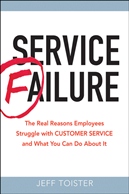Breaking the law + not calling back = bad service
 Jeff Toister
Jeff Toister  Tuesday, August 17, 2010 at 8:07AM |
Tuesday, August 17, 2010 at 8:07AM | My wife, Sally, and I are in the market for a new sliding glass door for our patio. We received a referral from a trusted source, so it seemed like finding a reputable company would be easy. It wasn't. And we're still in the market - do you know anyone good?
No call back #1
I made my initial call to request a quote and was told by someone in the office that the owner/salesperson was with a customer and would call me back. Unfortunately, that call never came. I would have written the company off, but the referral came from a trusted source. I wondered if the office person failed to give the owner the message. OK, I decided, I'll give them another shot.
The owner, Russ, was available the second time I called and we had a good chat. We set up a time for him to come out to the house, take a look at things, and provide an estimate. He arrived for the appointment on time, took some measurements, shared some options, and then left with a promise to submit a proposal within a couple of days.
Breakin' the law
The proposal arrived promptly a day or so later. It was simple, straightforward, and illegal. In California, a contractor can ask for a maximum of 10% up front. Russ wanted 50%. This was a giant red flag.
No call back #2
Sally called this time to speak with Russ and discuss the contract. Perhaps we are jaded from a horrific remodeling experience a couple years ago, but we still believed that good referrals were hard to come by and it was worth being patient. Russ was out of the office that day, but the person promised to have Russ return our call when he was back to the office.
Of course, Russ never called. (You knew that, didn't you?) After waiting a few days, I emailed a response to Russ's proposal and said, "No deal." I even outlined the reasons why. No response from Russ.
Word travels
I wanted to be sure my referral source knew about Russ, so I gave him a call and told him the story. He was surprised and said that sounded very unusual. He also asked if I was OK with him sharing this feedback with Russ. "Sure," I said, "it won't be anything I haven't already shared with him via email."
The plotten thickens with lame excuses
The next day I got a voice message from Russ. He said he had heard that I was unhappy, but said he hadn't gotten any messages from us or he would have called. He also defended his contract, saying he had done business this way for many years.
Needless to say, I didn't bother calling Russ back. After all, there was little to talk about and if he wasn't in he probably wouldn't get the message.
Lessons for business owners (but mainly Russ)
Here are a few lessons I take from this situation.
- Get really good at spotting weak links in the chain. This office person could be really hurting his business if Russ consistently misses out on callers who want to do business with him.
- Don't write illegal contracts. One, because it's ILLEGAL. Two, because it shows you don't understand your business. Three, because it demonstrates a lack of respect for your customers.
- Don't defend your illegal behavior on voice mail. Really, Russ? You've left a recording that I can take to the Contractor's State Licensing Board?






